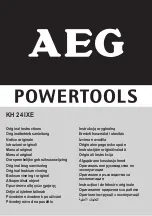
6
1.
2.
3. Remove the bit from the tool.
4.
5.
•
•
•
Drilling Large Diameter Holes
with Core Bits
When drilling holes with large diameter core bits,
dust may build up in the cut and can cause the tool
to stall, bind, or cut slowly. By creating an opening
for the dust to escape, drilling time, bit stress, and
tool stress can be reduced.
5. Start the tool. After drill-
ing to about the depth
of the core bit teeth,
remove the centre pin
and guide plate from
the core bit (not nece-
sary for LHS system).
Resume drilling.
6. To change the core bit, hold the tool upwards,
in forward to loosen the core bit from the adapter.
6. Reinstall the core bit and con-
tinue drilling. Dust and debris
will fall through the hole and
optimize the cutting ability of
the bit.
7. For core bits, once the maximum
core bit depth is drilled, the core
must be broken and removed.
WARNING
To reduce the risk of personal in-
•
Install a chisel bit.
•
Place the chisel into the hole
kerf.
•
Chisel down into the kerf at
several points until the core is loose or broken.
•
Remove the core and vacuum/remove any remain-
ing dust and debris.
•
Install the core bit and continue the cut.
jury and damage to the tool or work:
1. Place the proper size tooth anchor chuck into the
2.
•
Always use the “hammering-only” setting to
set the anchor. Never use the “hammering-
with-rotation” setting to set the anchor.
•
Never switch the tool to “hammering-with-
rotation” until after the anchor has been set
and the tooth anchor chuck has been removed
from the anchor.
“B” taper adapter. Then insert the “B” taper adapter
into the tool and lock it into place as described.
See “Installing Bits and Chisels”.
3 mm (1/8")
Set the knob for ham-
Insert the anchor into
the tooth anchor chuck.
mering only. Set the
anchor on your mark
the concrete.
teeth have penetrated
3.
and hammer until the
concrete.
NOTE:
It may be nec-
essary to clean dust
and cuttings from the
anchor several times
while drilling the hole.
Use caution to prevent
exposure to dust.
Drill a hole
through the
work.
Depending on the location of the
work, the hole should either break
through the other side of the hole/
Top view
Cut
approximately
6.35 mm (1/4")
deep with a
core bit.
diameter, onto the tool.
Install a standard fluted bit,
approximately 22.2 mm (7/8") in
4. Remove the anchor
from the hole while the
tool is running. Clean
the dust and cuttings
from the anchor by
pointing it downward and turning the tool on and
off several times. Clean the dust out of the hole
with a vacuum cleaner or blowout bulb.
5. Place the expansion plug into the anchor and insert
the anchor into the hole. Switch the knob back to
into the hole.
floor or extend 101.6 mm - 127 mm
(4"-5") past the end of the
workpiece (such as into the dirt
the kerf of the large hole.
Start the cut as normal.
Once the bit is firmly established in
the cut (about 6.35 mm (1/4")
deep), remove the bit from the cut.
Drill a perpendicular hole through
of slab
Side view
hammering
Set the knob for
with
below a concrete slab).
Dust and debris
If dust builds up in the hole,vacuum
will fall through
the hole.
it out and continue drilling.
If drilling through a wall, the hole for dust should be
drilled on the lowest part of the large hole kerf as
the dust will fall there when drilling and can be
easily removed.
rotation and drill until
the chuck is 3 mm
(1/8")
above
the
Pull bit out as far
Setting Self-Drilling Anchors
MILWAUKEE
®
Tooth Anchor Chucks require a “B”
taper adapter.
as possible once
(inch) drilled.
or twice per mm
4. Press the centring bit
firmly against your
centre mark, hold the
tool firmly and pull the
trigger.
NOTE:
To make deeper holes, remove the core
bit, break and remove the core, then resume
drilling. When drilling long or deep holes, after
each 25 mm (1") of penetration pull the bit
partially out of the hole while the tool is running,
to help clear dust from the bit flutes. Dust can
clog the bit flutes and can make the bit bind in
the hole. If this occurs, stop the tool, free the bit
and begin again.
NOTE:
If unable to drill a hole in
the kerf, pull back on the bit with
the hammer running. This will
remove some of the dust and
debris from the cut. Repeat this
for every 25 mm (1") of drilling. If
necessary, vacuum dust and
debris from the cut and
surrounding area.


















